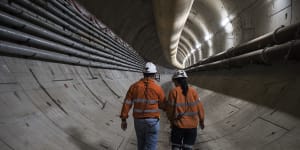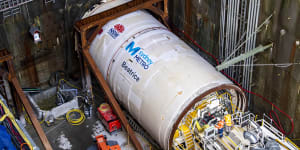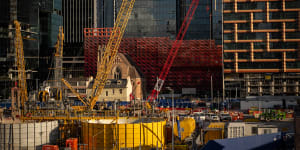While the boring machines can march forward,they cannot be pulled backwards through the twin tunnels they have dug because the concrete walls make them smaller than the tunnels they initially carved out. If their work grinds to a halt,they cannot be easily extracted from deep below.

The Metro West rail line is planned to run underground from central Sydney to Parramatta and Westmead.Nick Moir
Therein lies just one of scores of logistical,financial and political headaches a new Labor government will have to contend with if it decides to scrap the between Sydney’s CBD and Parramatta.
Almost four months after commissioning a into Sydney’s mega rail projects,Premier Chris Minns cast serious doubt on the future of Metro West this week when he repeatedly declined to say whether he would cancel the project.
His remarks have suddenly created uncertainty for commuters desperate for improved public transport services in western Sydney,small businesses that invested on the premise of the bold plans for the railway and contractors and their large teams of construction workers who are labouring around the clock to build the massive underground line.
Within months,Minns faces one of the biggest decisions of his premiership – will he cancel Australia’s largest public transport project,significantly reshape it by adding stations and changing the rail link’s alignment or delay the planned 2030 opening by years?
Les Wielinga,the head of the state’s transport bureaucracy between 2009 and 2013,says it will be hard for the premier to dump Metro West because of the key electorates that the line will pass through and the strategic need for the project. “It is all about the need for capacity at the end of the day,” he says.
The former senior public servant supports Minns taking a forensic look at Metro West,which is churning through up to $5 million a day. “Where the money is coming from has to be answered,” he says. “He has to make sure he gets on top of the[project cost] and has the right people to build it. That has to be thought about now because you don’t get a second chance.”

Beatrice and Daphne,another giant boring machine,began digging tunnels for Metro West several months ago.NSW government
The underground line’s cost is significantly greater on a per-kilometre basis than the two first stages of Sydney’s emerging metro network – the line under the harbour and CBD,and the line from Rouse Hill to Chatswood,which opened in 2019. The bigger bill for Metro West is blamed partly on the cost of acquiring properties – many of them in the CBD – which has topped $3 billion.
Internal Sydney Metro documents obtained by theHerald show the government has a massive funding mountain to climb for Metro West over the next five years,even after it has forked out almost $8 billion on the project. Internal estimates in mid-2020 – shortly before the pandemic sent construction costs skyrocketing – warned that the total cost risked ballooning to

Despite Minns saying this week that the project had “barely begun”,construction work is progressing across the 24-kilometre rail corridor. Excavators clawed away this week at a two-storey office building near The Star casino in Pyrmont,which will be the site for a Metro West station. In Parramatta,an entire block in the CBD has been razed for the project. Local businesses long ago made investment decisions on what was promised.
The financial and political consequences are so significant few believe that Minns will decide to ditch Metro West. A cancellation of a mega project that is well under way with many of the major contracts awarded would trigger compensation payments to contractors,as well as throwing on the scrap heap almost $8 billion spent so far.
Labor gave no hint to voters during the election campaign early this year that it would consider ditching Metro West,opening it up to accusations that to do so would be a betrayal of the electorate. In fact,it had dropped a pledge it took to the 2019 poll to of a 13-kilometre stretch of the Bankstown line,which is part of Metro City and Southwest rail project. Ironically,it promised at the time to use funds from the Bankstown line conversion to speed up Metro West.
Minns’ move this week makes the most likely outcome that Metro West will be delayed – and potentially a station or two added to the rail line in suburbs such as Camellia or Silverwater. Under the existing plans,a seven-kilometre stretch between Sydney Olympic Park and Parramatta is easily the longest section without a station.

While developers and mayors lobby for more stations,Wielinga believes the nine planned are adequate. “You have to locate them strategically. Every time you put in a station it increases the length of time it will take to get into the city,” he says. “Travel time is what it is about for commuters. You have to build them for the customers. Otherwise,there is no point doing it.”
Any move to add more stations will also significantly boost the cost of Metro West,which runs counter to the Labor government’s aim to rein it in. Internal estimates by Sydney Metro three years ago put the cost of each station for the line at between $350 million and $640 million.
The internal documents show that,as far back as mid-2020,Sydney Metro was considering a range of scenarios to delay the opening of the rail line until as late as 2034 due to Treasury pressuring it over the surging costs. Cutting the ribbon on the line in 2034 would make it four years later than existing plans to open it in 2030. That date is already two years behind the former Baird government’s for it to start carrying passengers in 2028.
Eamon Waterford,chief executive of the Committee for Sydney think tank,says the government is playing with fire. “[The cost of] Metro West is a very large number,so they look at it and say this could solve all of our woes in one go. They’re trying to fix a budget deficit,but they’ve picked maybe the most important project for the transformation of Sydney over the next decade,” he says. “The cost is high,but the benefit is higher.”
Mathew Hounsell,a researcher at the University of Technology’s transport research centre,says the long time it is taking for patronage across Sydney’s rail network to recover from a slump during the pandemic makes a delay to Metro West’s opening palatable.
“There is not as much demand for trips to the CBD,so it is possible that the delay will not be a problem,” he says. “But as the number of people in Sydney increases and road congestion worsens,more people turn to trains.”

Figures show that patronage on the existing suburban rail lines,which will be relieved the most by extra capacity being added into the rail system by Metro West,is still some way from returning to pre-pandemic levels.
Average daily patronage on the T1 Western Line last month was about 83 per cent of that in November 2019,months before the pandemic forced governments to lock down populations. Patronage on the Inner West line in June was 70 per cent of that in November 2019,while that on the T1 Northern Line was 67 per cent of that four years earlier.
While a delay is a distinct possibility,experts and industry groups warn the danger is that it will only increase the project’s cost. “Halting major projects like the Sydney Metro West line mid-construction,with tunnel boring already in full swing,is going to cost the NSW taxpayer more in the long run,” Australasian Railway Association chief executive Caroline Wilkie says.
Warnings about the and the other rail projects in Sydney have been coming for years. Risks ranging from safety threats and further cost blowouts to a failure to meet long-term benefits are partly explained by their sheer scale. After all,those in Sydney are among the largest metro rail projects under construction anywhere in the world.

The construction site for the Parramatta metro station.Wolter Peeters
Grattan Institute transport and cities program director Marion Terrill believes it is no longer possible for governments to ignore the escalating costs in multibillion-dollar projects.
“The federal,NSW and Victorian governments are facing very high levels of debt,so something has to give. These major infrastructure projects are just so expensive and are at very high risk of cost overruns,” she says.
“It is very prudent for a new government to take stock of projects before committing to continuing no matter what. Governments have a lot of options to delay,defer and change the scope of projects.”
If Minns were to delay Metro West,he would be deferring not just a major transport policy but a key pillar of the government’s housing policy,which is to turbocharge density near transport hubs (transit-oriented development).
The current route alignment runs under Newington,Silverwater and Camellia,but without any stations. The government’s finalised strategic vision for Camellia involves transforming the industrial precinct into a “thriving town centre” with 10,000 homes,15,400 jobs and an 18-hour a day entertainment precinct.
Labor’s original 2009 plan for a western metro line contained stops at Silverwater and Camellia. It is conceivable that,next to Iron Cove,could also be added.
Reconfiguring the line and adding more stations would increase the yield of homes. Treasurer Daniel Mookhey when he said that,for the project to proceed,“we have got to be confident that it’s helping us deliver more housing in a housing crisis”.

Waterford,the Committee for Sydney boss,agrees with that wholeheartedly,but warns it cannot mean pushing the project into the never-never.
“More stations is a good outcome;a delay of five or six years is a terrible outcome. A two-year delay with two extra stations,that would be an understandable or perhaps reasonable outcome,” he says. “A delay of five or six years would be hugely problematic. We can’t afford to wait that long. Frankly,it doesn’t take five or six years to build two extra stations.”
Newly appointed Planning Department secretary Kiersten Fishburn says she wants a “joined up conversation” with her equally new Transport for NSW counterpart Josh Murray,about how to better sync transport infrastructure with housing objectives.
“The nirvana of planning is that you line up land use,transport and infrastructure planning all together,” Fishburn told a business function on Thursday,when asked about Metro West’s future. “We’ve got a way to go,but we’re improving.”
Opposition transport spokeswoman Natalie Ward says any delay to Metro West will be a cut to what Labor promised to voters at the March election. “They promised unequivocally that they were committed to these projects. Floating the idea of more stations is a delay tactic,” she says. “You have people relying on this and people have had their properties compulsorily acquired for it.”
Transport Minister Jo Haylen says the review into Sydney Metro was commissioned because its projects had such a big financial and social footprint on the state. “We are talking about a big spend,and big changes to the fabric of our city,and we need to be certain that the community gets the best benefit from an investment of such significance,” she says.
An interim report from the review led by former high-ranking federal transport bureaucrat Mike Mrdak has been handed to the government,while a final report on Metro West will be released as early as October.
Meantime,Daphne and Beatrice continue to churn through sandstone and taxpayer dollars,despite the question marks now hanging over the mega underground rail line that they are meant to be building.
The Morning Edition newsletter is our guide to the day’s most important and interesting stories,analysis and insights..